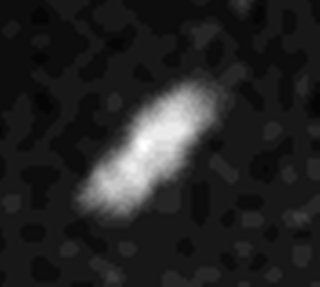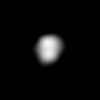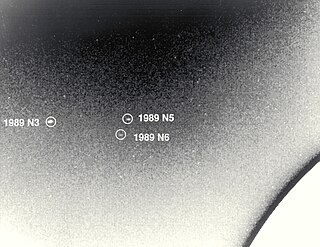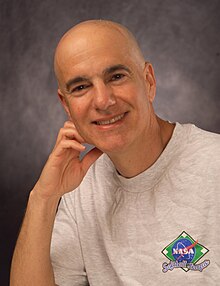
Naiad, named after the naiads of Greek legend, is the innermost satellite of Neptune and the nearest to the center of any gas giant with moons with a distance of 48,224 km from the planet's center. Its orbital period is less than a Neptunian day, resulting in tidal dissipation that will cause its orbit to decay. Eventually it will either crash into Neptune's atmosphere or break up to become a new ring.

Jupiter is the fifth planet from the Sun and the largest in the Solar System. It is a gas giant with a mass more than 2.5 times that of all the other planets in the Solar System combined and slightly less than one-thousandth the mass of the Sun. Jupiter orbits the Sun at a distance of 5.20 AU (778.5 Gm), with an orbital period of 11.86 years. It is the third brightest natural object in the Earth's night sky, after the Moon and Venus, and has been observed since prehistoric times. Its name derives from that of Jupiter, the chief deity of ancient Roman religion.

Belinda is an inner satellite of the planet Uranus. Belinda was discovered from the images taken by Voyager 2 on 13 January 1986 and was given the temporary designation S/1986 U 5. It is named after the heroine of Alexander Pope's The Rape of the Lock. It is also designated Uranus XIV.

A protoplanetary disk is a rotating circumstellar disc of dense gas and dust surrounding a young newly formed star, a T Tauri star, or Herbig Ae/Be star. The protoplanetary disk may not be considered an accretion disk, while the two are similar. While they are similar, an accretion disk is hotter, and spins much faster. It is also found on black holes, not stars. This process should not be confused with the accretion process thought to build up the planets themselves. Externally illuminated photo-evaporating protoplanetary disks are called proplyds.

Thalassa, also known as Neptune IV, is the second-innermost satellite of Neptune. Thalassa was named after sea goddess Thalassa, a daughter of Aether and Hemera from Greek mythology. "Thalassa" is also the Greek word for "sea".

Perdita is an inner satellite of Uranus. Perdita's discovery was very complicated, as the first photographs of Perdita were taken by the Voyager 2 spacecraft in 1986, but it was not recognized from the photographs for more than a decade. In 1999, the moon was noticed by Erich Karkoschka and reported. But because no further pictures could be taken to confirm its existence, it was officially demoted in 2001. However, in 2003, pictures taken by the Hubble Space Telescope managed to pick up an object where Perdita was supposed to be, finally confirming its existence.

Mab, or Uranus XXVI, is an inner satellite of Uranus. It was discovered by Mark R. Showalter and Jack J. Lissauer in 2003 using the Hubble Space Telescope. It was named after Queen Mab, a fairy queen from English folklore who is mentioned in William Shakespeare's play Romeo and Juliet.

James Barney Pollack was an American astrophysicist who worked for NASA's Ames Research Center.

An ice giant is a giant planet composed mainly of elements heavier than hydrogen and helium, such as oxygen, carbon, nitrogen, and sulfur. There are two ice giants in the Solar System: Uranus and Neptune.
Joseph Burns is a professor at Cornell University with a dual appointment in the Sibley School of Mechanical and Aerospace Engineering (MAE) and the Astronomy department. His primary area of research is dynamics in planetary sciences.
Philip D. Nicholson is an Australian-born professor of astronomy at Cornell University in the Astronomy department specialising in Planetary Sciences. He was editor-in-chief of the journal Icarus between 1998 and 2018.

Reta F. Beebe is an American astronomer, author, and popularizer of astronomy. She is an expert on the planets Jupiter and Saturn, and the author of Jupiter: The Giant Planet. She is a professor emeritus in the Astronomy Department at New Mexico State University and 2010 winner of the NASA Exceptional Public Service medal.

David Morrison is an American astronomer, a senior scientist at the Solar System Exploration Research Virtual Institute, at NASA Ames Research Center in Mountain View, California. Morrison is the former director of the Carl Sagan Center for Study of Life in the Universe at the SETI Institute and of the NASA Lunar Science Institute. He is the past Director of Space at NASA Ames. Morrison is credited as a founder of the multi-disciplinary field of astrobiology. Morrison is best known for his work in risk assessment of near Earth objects such as asteroids and comets. Asteroid 2410 Morrison was named in his honor. Morrison is also known for his "Ask an Astrobiologist" series on NASA's website where he provides answers to questions submitted by the public. He has published 12 books and over 150 papers primarily on planetary science, astrobiology and near Earth objects.
Dale P. Cruikshank is an astronomer and planetary scientist in the Astrophysics Branch at NASA Ames Research Center. His research specialties are spectroscopy and radiometry of planets and small bodies in the Solar System. These small bodies include comets, asteroids, planetary satellites, dwarf planets, and objects in the region beyond Neptune. He uses spectroscopic observations made with ground-based and space-based telescopes, as well as interplanetary spacecraft, to identify and study the ices, minerals, and organic materials that compose the surfaces of planets and small bodies.

Mark Robert Showalter is a senior research scientist at the SETI Institute. He is the discoverer of six moons and three planetary rings. He is the Principal Investigator of NASA's Planetary Data System Rings Node, a co-investigator on the Cassini–Huygens mission to Saturn, and works closely with the New Horizons mission to Pluto.

Kepler-56b (KOI-1241.02) is a hot Neptune—a class of exoplanets—located roughly 3,060 light-years away. It is somewhat larger than Neptune and orbits its parent star Kepler-56 and was discovered in 2013 by the Kepler Space Telescope.

Christina "Chrissy" Richey is an American planetary scientist and astrophysicist working at Jet Propulsion Laboratory in La Cañada Flintridge, California. Richey is a project staff scientist for the Europa Clipper mission and is a research technologist in the Astrophysics and Space Sciences Section. Prior to working at JPL, Richey worked as contractor for Arctic Slope Regional Corporation at NASA Headquarters in Washington, D.C. They were a program officer in NASA's Planetary Science Division, the deputy program scientist for the OSIRIS-REx mission, and the deputy science advisor for research and analysis for the Science Mission Directorate.

Amy Simon is an American planetary scientist at NASA's Goddard Space Flight Center, involved in several missions of the Solar System Exploration Program.

Lynnae C. Quick is an American planetary geophysicist and Ocean Worlds Planetary Scientist at NASA Goddard Space Flight Center. Her research centers on theoretical modeling of cryovolcanic processes on the icy moons and dwarf planets in the Solar System as well as modeling volcanic activity on Venus and the Moon. Quick is a member of the Dawn, Europa Clipper, and Dragonfly Mission science teams. She is also a member of the NASA Solar System Exploration Research Virtual Institute (SSERVI) Toolbox for Research and Exploration (TREX) team, and serves as co-chair of the Earth and Planetary Systems Sciences section of the National Society of Black Physicists.
Imke de Pater is a Dutch astronomer working at the University of California, Berkeley. She is known for her research on the large planets and led the team using the Keck Telescope to image the 1994 impact of the comet Comet Shoemaker–Levy 9 with Jupiter.
















